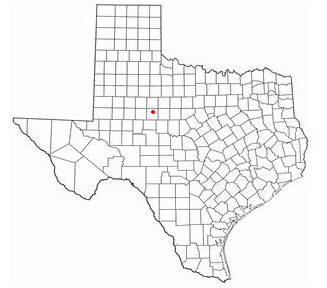It has been
called the "Mother City of West
Texas" for its early origin as a
ranger camp in 1877 and for its
prominence as a cattlemen's center.
In 1881 the town was chosen county
seat and acquired a station on the
new Texas and Pacific Railway. Local
ranchers hauled in tons of buffalo
bones (see BONE BUSINESS)
for shipment to the East and loaded
their empty wagons with provisions
purchased from pioneer merchant
William H. "Uncle Pete" Snyder and
others. When the town was granted a
post office in 1881 Prince A.
Hazzard became the first postmaster.
Water was hauled to town from Seven
Wells and elsewhere and sold at
fifty cents a barrel. The first
school, conducted in a dugout in
1881, was moved to a building the
next year, and soon a new building
was built.
By that time the
town had between 200 and 300
residents and was a cattle-shipping
center. Ranchers drove their cattle
to Colorado City from as far north
as
Amarillo, from as far south as
San Angelo, and from eastern New
Mexico. Great herds were held until
rail cars were available. After
shipment, cowboys were free to enjoy
the town's amenities. Between 1881
and 1884 its five saloons multiplied
to twenty-eight, and other
businesses showed the same growth.
The population was estimated as high
as 6,000 in 1884–85. The boom slowed
after the 1885–86 drought, however,
and the 1890 population was 2,500.
In May 1881
W. P. Patterson, a prominent
rancher, was shot down by Texas
Rangers Citizens blamed the shooting
on the rangers' feud with cattlemen,
and the ranger camp was moved from
town to Hackberry Springs, twenty
miles southwest. When Amarillo
developed with the arrival of the
Fort
Worth and Denver Railway in 1887
and when the Santa Fe Railroad
reached
San
Angelo a year later, business in
Colorado City declined sharply.
During the 1890s salt mining was
important to the local economy, but
salt declined in importance after
1900.

A second
boom between 1900 and 1906 followed
the influx of farmers. The
population of Colorado City was
3,000 in 1906. By 1910 the town had
a new public school, a waterworks,
and an electric plant. In 1914 the
population was estimated at 1,500,
and the town had two banks and a
newspaper, the Colorado City
Record. Though the drought of
1916–18 adversely affected local
farmers, interest in oil increased.
In 1916 the Consolidated Oil and Gas
Company of Colorado was organized by
local bankers, businessmen, and
merchants to develop the area's oil
and gas resources, and by 1920 oil
production was a part of the local
economy. The Col-Tex Refinery began
operation in 1924. By 1926 a city
hall had been built, the streets
were paved, and a new sewage system
was in operation.
In 1931
Colorado City had an estimated
population of 4,761 and 200
businesses. By 1940 the population
had increased to 5,213, but by 1945
the number of reported businesses
had declined to 120. In the late
1940s increased oil activity in
Mitchell, Scurry, Coke, and Borden
counties caused some growth, and by
1949 the number of businesses in
Colorado City had increased to 176.
During the mid-1950s a drought, the
longest on record, affected the
area's agricultural production,
particularly of cotton. In 1955 the
population was 6,774. Lake Colorado
City, five miles southwest, was
built in the late 1940s, and
Champion Creek Reservoir, six miles
south, was built in 1959. The
population was estimated at 6,400 in
1965. The Col-Tex Refinery closed in
1969, but in the early 1970s new
industries were established,
including a meat-packing operation
and a mobile-home plant. Colorado
City had 5,300 residents and 126
businesses in 1975. In 1990 it had a
population of 4,749, a hospital, and
104 businesses. Local attractions
include the Colorado City Historical
Museum, the Colorado City Playhouse,
and an annual rodeo. In 2000 the
population was 4,281, and the
community contained 234 businesses.









